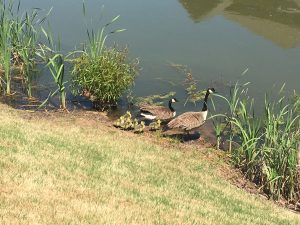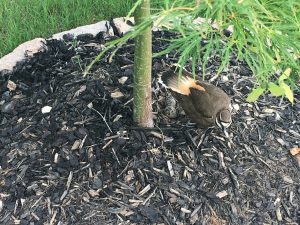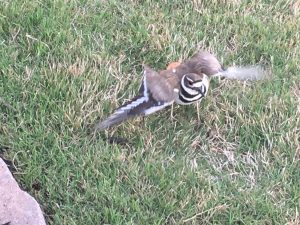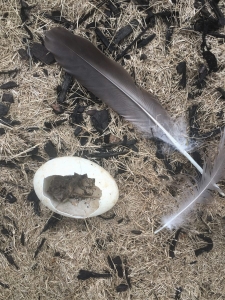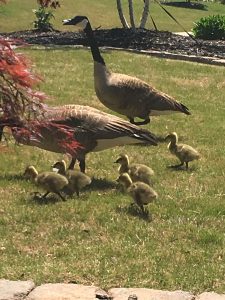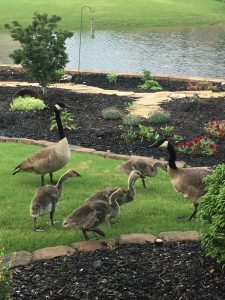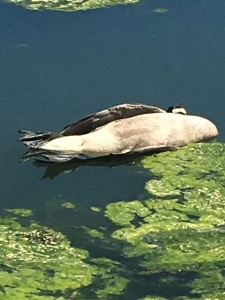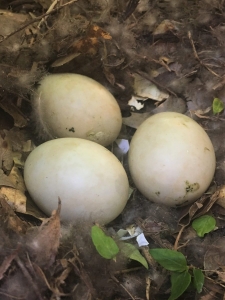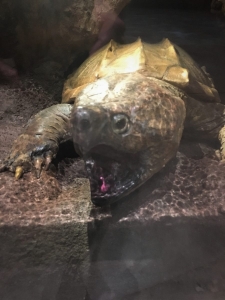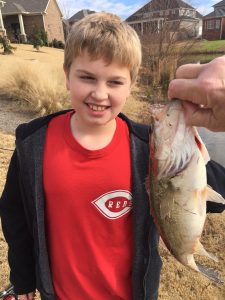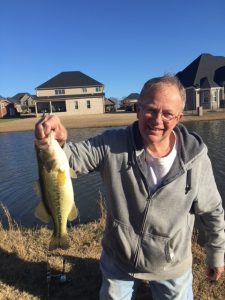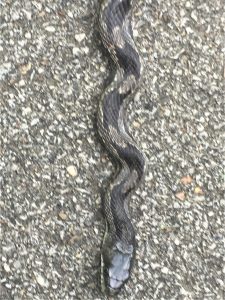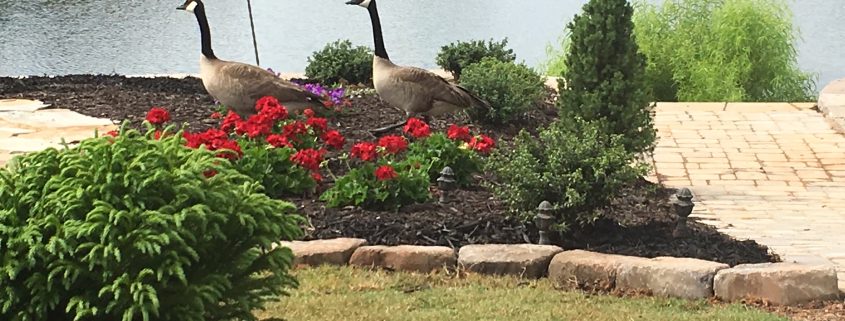Peace, Tranquility, and Serenity
I speak often of Nature’s beauty, magic, wonder, and awe. Judy and I normally complete our morning neighborhood walk by 6:00AM, then enjoy coffee on the patio overlooking four-acre Big Blue Lake (BBL), along whose north shore we reside.
We experience peace, tranquility, the onset of a new day, a gentle stirring of birdsong and breeze, soft colors, and the promise of a full day ahead. That’s how every day in Nature’s beatific world unfolds, right? An Eden where life embraces life… among all creatures great and small. Where peace and harmony dominate life and living!
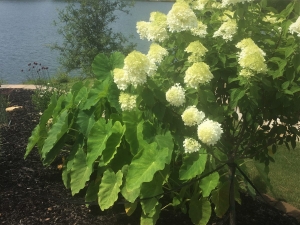
Sure, one may presume on such placid dawnings that all is love and joy here on BBL—and the lion shall lie down with the lamb! But wait, there is more. I choose to focus my writing on Nature’s inspiration–I relate her everyday tales in ways that lift lives and elevate the human spirit. However, I am not a Pollyanna, nor am I blind to Nature’s complex ways and multiple faces. As an applied ecologist, I know that Nature is harsh. The food chain is real. Few animals reside at the apex. Every organism, dead or alive, is edible to some consumer, primary or secondary. Death begins at the onset of life… and life at the time of death. From the Christian hymn:
-
- “Will the circle be unbroken
- By and by, by and by?
- Is a better home awaiting
- In the sky, in the sky?”
The secular is absolute… ashes to ashes, dust to dust cannot be denied. A better home awaiting is a matter of Faith and of Spirit. Okay, I will leave the Spiritual element of the cycle of life and death to another day. Allow me now a quick recitation of just a few examples of the cold, brutal violence among BBL’s community of life from just the past few weeks. My intent is not to generate despair, but to illustrate that life is a complex web. Nature does not pass judgment. She is objective. Only we humans see good and evil, right and wrong, honest and deceptive. Nature just is… nothing more.
Two-hundred fifty years ago, Leonardo da Vinci observed of Nature: “In her inventions nothing is lacking and nothing is superfluous. Nature is the source of all true knowledge. She has her own logic, her own laws, she has no effect without cause nor invention without necessity. Nature never breaks her own laws.” Every morning we witness Nature’s fidelity to the laws she has adopted and observed over 3.7 billion years of life on Earth. Life and living on Big Blue Lake never break Nature’s laws. Serenity? Yes, the beauty, magic, wonder, and awe are present. No denying the obvious (below).
The Cold, Harsh, and Unforgiving Dimension
Yet, just as obvious, there are two sides to the coin of life. No, not really sides, but a continuum. For example, we have a resident sharp-shinned hawk on BBL. I say resident only because we see this aggressive predator every couple of days. I have no idea the extent of its range beyond frequenting BBL and posting near our quite active bird feeders.
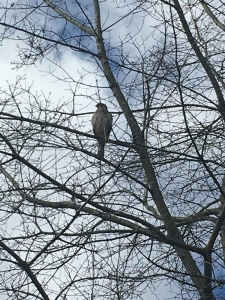
Twice this spring we observed first-hand two near misses. A dove lighted off the patio in our back ornamental bed just ten feet from our own patio perch. Within seconds, Sharpy stooped suddenly from above onto the fortunate dove. Fortunate only because after feathers exploded, both birds immediately departed the chaotic scene. Down and a few tail or wing feathers marked the scene (below left). We’ve previously found such impact evidence in the backyard. I’ve always assumed a kill had resulted. Just three days following the near-miss, we witnessed Sharpy hitting another dove just 20-feet away… this one in flight. Again, a puff of feathers and two birds leaving in opposite directions. I pondered… an outstanding baseball batter will connect successfully three out of ten at-bats. What’s the hit-rate for sharp-shinned hawks? Three of ten? I found the feathers below right in mid-June. Another miss?
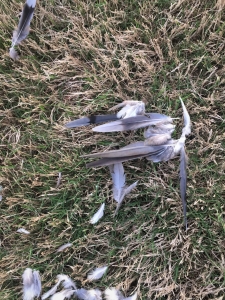
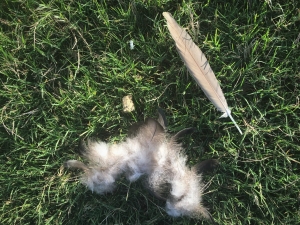
We know without doubt that dove-life on BBL is not free and easy. Aldo Leopold wrote of the need for geese on his Wisconsin farm to be vigilant about their place in the food chain. He asked, as he lamented the efficacy of a modern education 70 years ago, “Is education possibly a process of trading awareness for things of lesser worth? The goose who trades his is soon a pile of feathers.” We occasionally see Sharpy nearby. Just two weeks ago, we heard our setting killdeer (15 feet off of the patio) screaming in serious agitation. We peeked from our sun porch. Sharpy stood ten feet from the mamma-less nest, then walked to within six inches of the four eggs, never seeming to notice them. We were prepared to rush out to save the eggs if necessary. As you will soon read, we had already lost a clutch of four killdeer eggs to a gang of ruffian crows in late March. Sharpy abruptly left without our exiting the house.
I recently finished reading Wendell Berry’s Our Only World, published 65 years after Leopold’s A Sand County Almanac. Interestingly, Berry came to a conclusion similar to Leopold’s: “There can never be too much knowledge, but there certainly can be too much school.” Perhaps a sacrilege from a former university president (four institutions), yet I fear that a modern university education is heavy to things of lesser worth.
Marauding Crows
Early March our killdeer couple that had successfully fledged two broods of four last summer, returned to their nesting site near a Japanese maple just 15-feet from our patio.
The adults at first performed the broken wing act to lure us from the nest and soon, accustomed to us, they would sit quietly as long as we gave them a reasonable berth.
During our morning patio-relaxing time this spring, five noisy crows would enter and pass through our little paradise. We would hear and see them emptying the sunflower seed feeders, one doing the feeder work while the others collected seed knocked to the ground. They would likewise make short work of a suet cage. We found them to be obnoxious bird-bullies, yet I accepted them as part of Nature’s web on BBL. Later one morning as we ran errands, our next door neighbor heard a loud clamor of crows and killdeer, and emerged to her porch in time to see the crows completing their task of scattering the killdeer parents and eating the four eggs. The crows have not been frequenting our end of the lake for the past six weeks.
Before the crows abandoned us, they also destroyed five goose eggs at our shoreline (goose at nest below left). The same neighbor heard the noise of the five crows attacking and eating the clutch of goose eggs (below right). I suppose there is good reason that the collective noun for a crow gang is a murder of crows! Will they return next spring? If so, what will I do, if anything, to dissuade them from their evil ways?! Yes, I know, it is I who place relative value, good and evil, preference among species of birds. I may simply observe and learn from Nature’s ways.
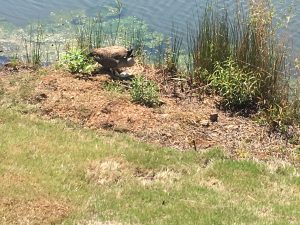
We did raise (actually, we observed and did not participate) two successful killdeer hatches last summer. Likewise, a goose pair raised a clutch of five goslings from their shore-side nest at our place (below). This summer, we’ve watched goose families of three and six goslings cruising BBL. This morning I counted 39 geese on the lake, including the nine goslings. Despite the murder of crows, I sense that we are at least sustaining our goose population.
Some good news. We now have another four killdeer eggs at the identical location and estimate a late June hatch date. I’m completing final editing July 1; the parents are still tending the four eggs. We anticipate hatching any moment. A last minute update: the four hatched mid-morning July 2, then spent the night under Mom’s wings. We watched them venture forth to lakeside during the morning. We celebrated their success!
Goose Homicide
All of our goose problems are not attributable to marauding corvids (family of Corvidae; crows and ravens). During pairing-off season, we noticed very territorial behavior among males. We’ve observed violence when a male senses competition for his mate. The aggrieved male will attack the perceived threat-bird. The aggressor will demonstrate a neck-parallel-to-the-water paddle toward the other male, leading to a flying attack that we’ve seen result in the target being taken underwater repeatedly with a great deal of thrashing. Occasionally the take-down lasted long enough that I wondered whether the attacked male would escape. In fact, in late April, one apparently did not. We found the victim floating belly-up at our shoreline. I waited several days, anticipating that our turtles would scavenge the corpse. Warm days compelled me to place the body in a large plastic bag and transfer the corpse to our garbage can for disposal.
Heron
We have what we consider our resident great blue heron. Again, the bird’s range includes BBL, but is certainly not exclusively restricted to BBL as its domicile. A rookery (below left) is perhaps six miles distance. I have little idea of how far a heron may range from its home rookery. We see Big Blue (our name for the resident bird) often. We’ve spent many hours in total watching the bird hunt along our shore. Few things surpass the thrill of seeing a thrust or dive resulting in a catch, whether a frog or fish large enough to witness repeated stabs, de-mobilization, and maneuvering to swallow head-first. These magnificent wetland birds are voracious predators. I view them as symbolic of Nature’s beauty, magic, wonder, and awe. Were I an intended meal, I would see our heron as an imminent threat, a fearsome beast, a horrible monster hell-bent on ruining my day. I enjoy peace and tranquility in observing the stealthy, stilted, royal heron. The frogs, fish, and snakes of BBL do not share my enthusiasm and appreciation!
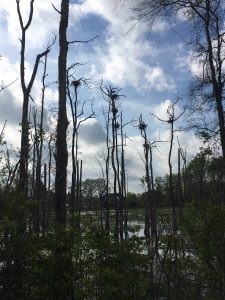
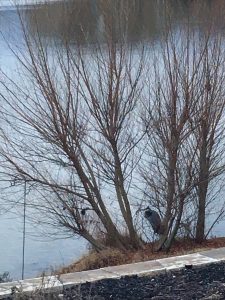
Ducks
The three eggs below remain from the ten eggs a female mallard deposited and tended in our front bed under a rosecreek abelia. The seven hatched overnight June 14. Momma had the ducklings on the pond within hours. As I write these words the afternoon of July 1, she is cruising with just three survivors. Interestingly, she appears to be a single mother. We’ve watched other families cruise BBL. Mom leads, the ducklings paddle in close single file, and Dad brings up the rear. We have not yet seen a male with our family group. As of July 10 (yesterday), the number remains at three. I puzzled over what percentage of mallard eggs in the wild typically hatch. Is 70-percent normal? I searched the web quickly for an answer, coming up empty. Same for what proportion of hatchlings normally survive to adulthood. Did the absence of Dad result in higher mortality?
Kingfisher and Osprey
We likewise frequently see kingfishers hunting along BBL. They perch on fence posts or in shrubs and trees watching the water before diving headlong for some hapless prey. Once this past winter we watched (with great surprise) a magnificent osprey approach from the southwest a couple of hundred feet above BBL, then circle slowly three times, carefully surveying the surface below.
Water Turtles
Big Blue Lake is home to water turtles, some of which are snappers, fearless predators in their own right. Fish, frogs, snakes, snails, and mollusks are among the prey. I’ve seen individuals approaching 18-inches from beak to tip-of-tail. I am sure that the snappers are responsible for some duckling and gosling mortality. Last year, we saw a duckling family of 11 winnow to four reaching adulthood. The parade of tiny yellow fuzzballs must look quite appetizing from beneath! The snapper below is a mount at the recently-opened Cook Museum of Natural Science in Decatur.
Insects and Spiders
Spiders like to set insect webs along our patio roof-line. It’s a tough life for flying insects. If not a spider’s meal, insects are subject to the species of large dragonfly that frequents our backyard a little later in summer. Barn swallows hunt BBL and its immediate air-space much of the day. Many of our common birds feast on insects, worms, and other small life forms.
Fish
Largemouth bass cruise the pond, consuming frogs, fish, and perhaps even the ducklings and goslings when swallowable size. I’ve had days when nearly every cast with a spinning lure draws a strike.
Snakes
We’ve spotted grey rat snakes several times this spring. In past years we’ve had garter snakes in our beds. They, too, consume birds, bird eggs, mice, and other rodents. By mid-June we had spotted five grey rat snakes road-killed at the entrance to our development, along a stretch of road bordered by mature hardwood forest. So sad to see the mortality. Unlike many neighbors, I find the sinuous reptiles beautiful and of great value within the complex faunal ecosystem. Regardless, I am grateful to be atop the food chain!
Other Factors
I show the male house finch temporarily stunned on our patio to evidence that not all dangers are biological. The finch flew into one of our back windows. He soon recovered and departed. Again, a tough life amidst BBL’s peace and tranquility.
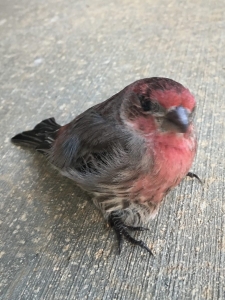
Mid Twentieth Century author, conservationist, and naturalist-philosopher Aldo Leopold observed, “A thing is right when it tends to preserve the integrity, stability and beauty of the biotic community. It is wrong when it tends otherwise.” Harsh as it may seem, life along BBL appears to be right. The ecosystem is complex, integrated, and I believe stable. I offer another Leopold quote as I think about the crows and how I might deal with them next spring, “To keep every cog and wheel is the first precaution of intelligent tinkering.” Whether cog or wheel, the crows are integral to our functioning ecosystem. I will likely accept them as too important for me to pass judgement and issue a sentence.
Thoughts and Reflections
I wrote my books Nature Based Leadership (2016), Nature-Inspired Learning and Leading (2017), and Weaned Seals and Snowy Summits: Stories of Passion for Place and Everyday Nature (2019; co-authored with Dr. Jennifer Wilhoit; Submitted to publisher May 31, 2019), as well as another one by me (single author) scheduled for 2020, Natural Elixir: Lifting Your Life through Nature’s Inspiration, to encourage all citizens to recognize and appreciate that every lesson for living, learning, serving, and leading is either written indelibly in or is powerfully inspired by Nature. Both published books are available on Amazon and other online sources.
Here are the four succinct lessons I draw from this Blog Post:
- Nature is objective, refusing to pass judgement or assign relative worth.
- Follow the rule of intelligent tinkering
- Nature is the source of all true knowledge. She has her own logic, her own laws, she has no effect without cause nor invention without necessity.
- There is always a flip side to Nature’s apparent peace, serenity, and tranquility.
Inhale and absorb Nature’s elixir. May Nature Inspire and Reward you!
Note: All blog post images created & photographed by Stephen B. Jones unless otherwise noted. Please circulate images with photo credit: “©2019 Steve Jones, Great Blue Heron LLC. All Rights Reserved.”
Another Note: If you came to this post via a Facebook posting or by an another route, please sign up now (no cost… no obligation) to receive my Blog Post email alerts: https://stevejonesgbh.com/contact/
And a Third: I am available for Nature-Inspired Speaking, Writing, and Consulting — contact me at steve.jones.0524@gmail.com
Reminder of my Personal and Professional Purpose, Passion, and Cause
If only more of us viewed our precious environment through my own filters. If only my mission and vision could be multiplied untold orders of magnitude:
Mission: Employ writing and speaking to educate, inspire, and enable readers and listeners to understand, appreciate, and enjoy Nature… and accept and practice Earth Stewardship.
Vision:
- People of all ages will pay greater attention to and engage more regularly with Nature… and will accept and practice informed and responsible Earth Stewardship.
- They will see their relationship to our natural world with new eyes… and will understand more clearly their Earth home.
Tagline/Motto: Steve (Great Blue Heron) encourages and seeks a better tomorrow through Nature-Inspired Living!

